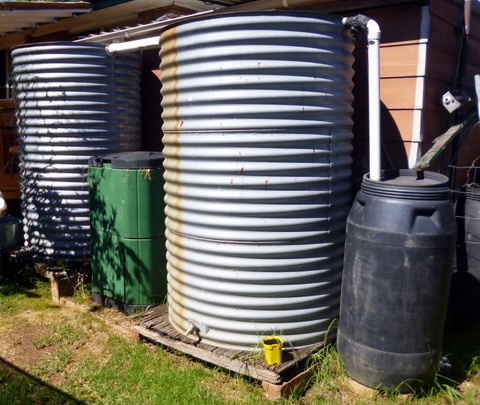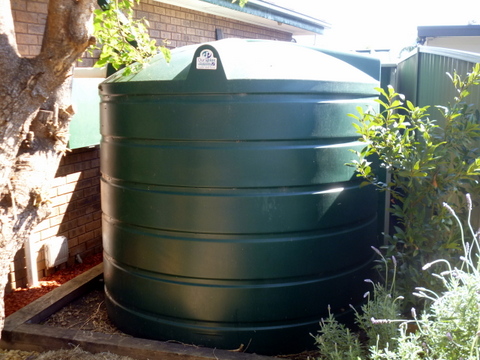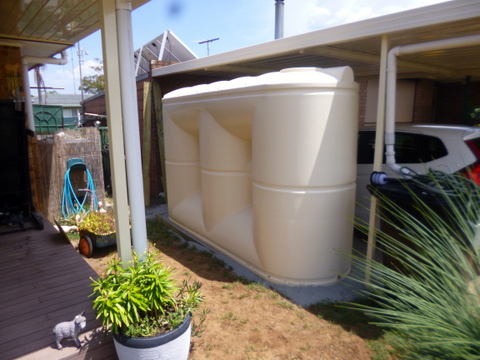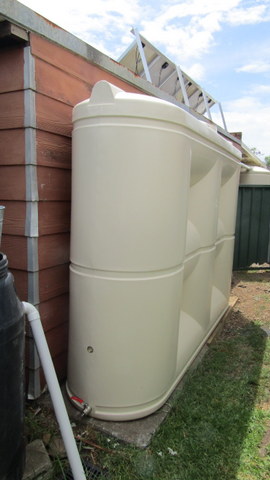We have a number of smaller rainwater tanks rather than one large one, and there are a number of advantages to this approach –
1. While one large tank is costs less per litre of storage, it is still going to cost more to start off with. Installing a number of smaller tanks over time spreads out the financial load.
2. Space – Our place is pretty intensely planted and we don’t have vast amounts of room for water tanks. A number of smaller tanks are much easier to fit in and around our yard than one humungous one.
3. Ease of installation – I have installed all of our tanks and been able to move them around by myself or with the assistance of one other person. A very large tank is likely to require installation by professionals.
4. Handy access – with smaller water tanks strategically placed around our back yard, we can access the water where it is needed by gravity for the most part. The exception is the 5,500litre tank in the north of the front yard, which has a small 12volt pump connected.
5. Resilience – If you have a single tank and it becomes contaminated or someone leaves the tap open (both of which have happen to various tanks on several occasions, your entire water supply may be rendered unusable. With many smaller tanks it is not any less irritating but if it’s only one of many it is not as devastating.
Anyway, we have found that the ‘many tanks’ approach has worked for us. Lately, however, due to drought and high temperatures I have become passionately interested in tracking our rainwater use, and (as I am sure you are sick of hearing from me) what you don’t measure, you don’t control!
So I have devised a method to help me keep track of how we are going, using Excel, and this is how I did it –
I opened up Excel and started on a new spreadsheet
I allocated each tank a number, just to make things easier for me to keep track of what I am doing and recorded the nominal volume of each of the tanks, ie, the volume we were told when we bought them. I then measured the effective height of each tank (ie from the bottom of the tank to be bottom of the overflow pipe) in millimetres and recorded that. By dividing the nominal volume (in litres) by the effective height (in mm) it gave me an average figure of litres per millimetre for the height of the tank.
Now, this idea works remarkably well for our cylindrical tanks, but less well for the skinny, tall form tanks. This is because the skinny tanks do not have a uniform profile, but have cut-outs in the middle to prevent the tank bowing outwards due to water pressure when they are full. I am happy that the figures I get will contain some inaccuracies but still give me a rough idea of how much water we have/are using.
So now the trick is to measure the water level in the tank. There are a number of contraptions and appurtenances on the market that can help you do this, for varying cost and level of complexity, but for me the best (and most cost effective) process is the ooooollllld Tappa Tappa!
This just involves tapping the side of the tank with your hand or any other hard object hanging around, moving upwards along the side of the tank until the tone goes from dull thud to a cavernous echoey tap. Then measure that level in millimetres from the bottom of the tank. Temperature change also works fairly well in warm weather on steel tanks with the bare hand, but less so on the plastic ones.
So with the millimetres up from the bottom of the tank to the water level, and the number of litres per millimetre of tank height you can work out how much water is left in the tank by multiplying one by the other. Record that for each tank and you can work out how much water you have left in your system by just adding them up. You can, if you so desire divide the water left in litres into the total capacity of your storage and multiply by 100 to give you what percentage of your water storage is left. Whatever works for you!
Of course the advantage of doing this is it gives you a handle, over time, on how much rainwater you are consuming. Bearing in mind that predictions seem to be saying we will be getting less rain events, but the rain events themselves will be more intense, you may want to install more tanks!
A copy of my spreadsheet can be downloaded here







